In this Education for Climate Justice blog series, we bring you new research, case studies and examples of education for climate action from across the globe. We aim to provoke discussion and encourage learning and collaborations that promote environmental and social justice through new models and practices of education. This series is supported by JustEd at the University of Bath.
This blog was written by: Priyanka Krishna and Bhawna Parmar, Quest Alliance, India; Dr Claire Lee, Oxford Brookes University; Dr Aminath Shiyama, The Maldives National University; Dr Terra Sprague, University of Bath.
In this latest instalment of our blog series, we hear from two research projects – one based in India, the other in the Maldives and the UK – that have used pedagogical practices to help young learners respond to climate change through futures framing and cross-cultural dialogue. These projects illustrate how emergent, creative pedagogies are enabling teachers to explore environmental injustices in ways that help learners overcome their eco anxieties and look to the future with hope.
During the months of April and May, as part of Conversations for Change, we’ve been running a virtual and in-person Future Creating Workshop. Through this methodology, participants have been addressing the topic of Climate Justice education by critiquing the status quo, developing a utopian vision of education for climate justice, and proposing a set of actions to realise this vision.
In India, the Building Emancipatory Climate Future Thinking in Youth project works at the intersection of climate crises shocks and stressors (floods, droughts, cyclones and heat waves) within the three highly climate vulnerable states of Odisha, Assam, and Gujarat. The project explores how young people navigate climate change and what plural climate justice means for youth and their communities. Through the speculative futures method, young people are prompted to engage in personal and community futuring. In these spaces, they imagine solutions and adaptation strategies to the climate crises for themselves and their communities.
The findings show that initially, young people and communities, while aware of how climate shocks and stresses affect them, cannot draw larger connections to what drives climate change. In many instances, youth perceive the climate crisis to be a natural consequence which they have normalised as a part of their lives. However, when provided with collaborative, open safe spaces which prioritise criticality, they are able to draw meaningful connections of weather variability to climate change and identify systemic issues beyond individualised narratives of responsibility. Such spaces, as corroborated by student testimonies, enable them to think beyond the immediate. This furthermore allows them to articulate their positions and marginalisation, while foregrounding their voice and experiences.
For instance, in a school in Bojava village, Central Gujarat, girls from a historically marginalised Dalit community spoke of how access to water is differentiated, with privileged castes receiving piped water while the marginalised castes such as Dalits need to walk long distances to fetch water from hand pumps. They imagined that, should drought and lack of water occur in the future, they may have to leave their native village. They had concerns that their distress migration may reproduce the caste discrimination and inequalities and could worsen their access to water due to their precarious conditions and loss of livelihoods. One of their proposed solutions was for governments to create water banks for future scenarios of long droughts with the governing body having representation from all communities so that access is fair and just.
In another instance, in the mining region in Talcher in the state of Odisha in India, students already bear the brunt of extreme heat which scholars attribute to industrial activities like coal mining, aluminium smelting and steel making. Students at a public industrial training institute were prompted to consider solutions the government might introduce to solve the aggravating heat crisis. They suggested that a carbon tax levied on non-essential goods would decrease consumption, leading to a decrease in fossil fuel demand, and that meantime the tax for essentials must be decreased to make these more accessible for all.
The pedagogy used for the workshops with the youth participants involved futuring exercises, beginning with personal futuring where students are invited to think of their own futures in 20 years. Then they move outwards to a communities’ perspective where they consider the current challenges their communities face and are encouraged to imagine futures of their respective villages and states in relation to these challenges. Through the process, students are nudged and asked questions to move them from a state of anxiety about their futures to a place of hope. Futures thinking and literacy is argued to be a capacity. While this capacity may vary between communities, and is contingent on the level of marginalisation, this research project has found that there is a need to build this as a capability to open possibilities for young people to engage with the current climate crisis more critically while imagining hopeful, alternative possible futures.
Meanwhile, in the Maldives and the UK, the Our World, Our Futures project brings together researchers, primary school teachers and classes to develop a model of environmental education that mobilises and foregrounds children’s knowledges, concerns, future thinking and activism. Through digital sharing of art and other texts, children have been communicating their knowledge and ideas around the following four themes: ‘Where we live’; ‘Something we’d like to change’; ‘Our future space’; and ‘Making a change’.
The project seeks to understand how cross-cultural dialogue can develop children’s social, emotional and ethical understanding of the world, their empathy and their sense of self as global citizens. Another area of interest is whether this flexible, cross-curricular approach to environmental education is a viable alternative to a top-down, objective-driven curriculum, and could promote teacher autonomy and professional learning.
Emerging findings suggest that the dialogic nature of the project, involving a community of children as participants in intercultural communication, has not only extended children’s knowledge of the uniqueness of their own and others’ environments, but also fostered their empathy and their sense of interconnectedness. For example, in an online video discussion, for which children had prepared questions for their counterparts, children from the Maldives learned that the UK had no mangrove forests. The children from one school in the Maldives then decided to create a diorama which would teach the English children about mangroves and the important role they play in their islands’ ecosystems. Similarly, children from a rural area of southern England learned that the woodland animals they took for granted, such as hedgehogs, squirrels and foxes, were unknown to their Maldivian counterparts. They incorporated images of those animals into artwork to share with the Maldivian children. The real-time conversation facilitated by the digital platforms was powerful in connecting the children across time and space and enabling cross-context conversation about local spaces, while highlighting the similarities and differences in each other’s local environments and sustainability practices.
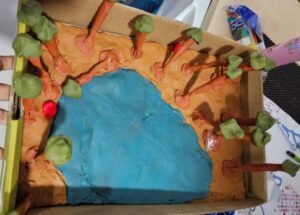 |
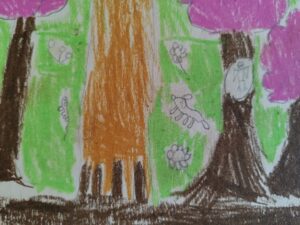 |
|
Diorama of a mangrove forest created by children in the Maldives, and a drawing of a woodland by children in the UK through Our World, Our Futures project. Photo Credit: Our World, Our Futures |
Findings also resonate with the arguments that environmental education cannot be a dispassionate endeavour, but, as Ojala argues, ‘to face the negative is a starting point for constructive hope,’ and children need to be able to imagine positive futures and routes to them. In one UK school, for example, children expressed shock at the existential threats posed to low-lying places such as the Maldives by rising sea levels. They decided to create 2D and 3D designs and models of homes and communities for the future. The level of detail they included, and their descriptions of the spaces, suggested the children not only designed the physical surroundings but also imagined liveable, sustainable systems and the lives they would lead within them. Their teacher commented: “part of me thinks that their thoughts are so fantastical and ‘out there’ that they’re just ridiculous. But they’re not. You know, they’re really sensible, well-thought-out ideas.” The children spoke about their hope that they might one day have the skills to realise their designs, or that others might see their designs and be inspired to put them into reality.
In this project, the children have not only learned about their peers’ local environments but have also started to reflect on their own local environments and the fragility of these from the perspectives of their counterparts. By supporting children to understand that their local environment is just one small part of a diverse yet interconnected world, the project also holds the potential to challenge ethnocentrism. In the face of environmental injustice, the capacity to imagine and design preferred future spaces, and their lives within them, may be one way of developing children’s capacity for hope.
—————————-
This is the second in the Education for Climate Justice blog series. Others in the series can be read here:
Education that listens to those most affected by climate change
Breaking beyond classroom walls to learn IN nature for climate justice
Girls and climate justice education: Experience from two initiatives
You can read other content on the UKFIET website relating to climate change and climate justice here, including more about our Conversations for Change event.

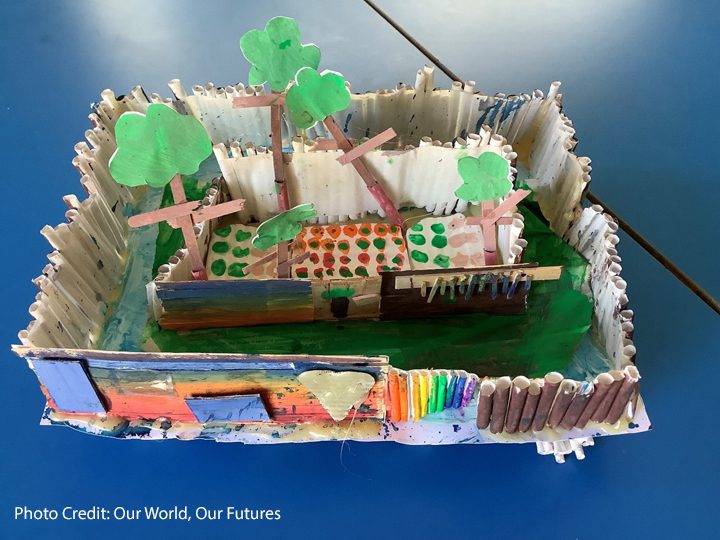
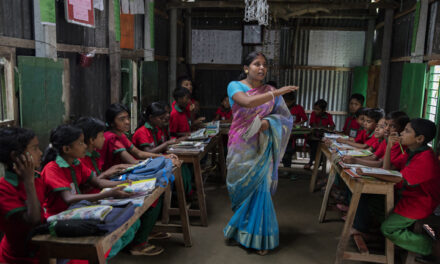
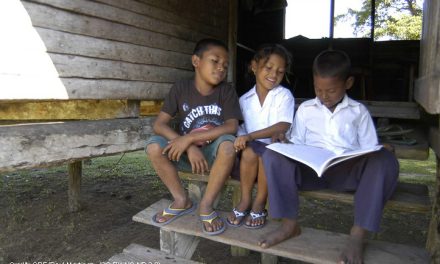
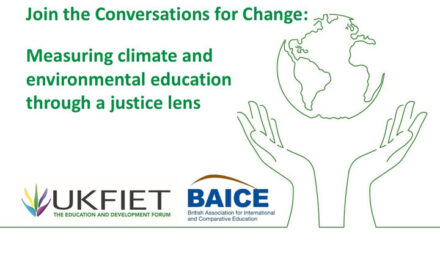
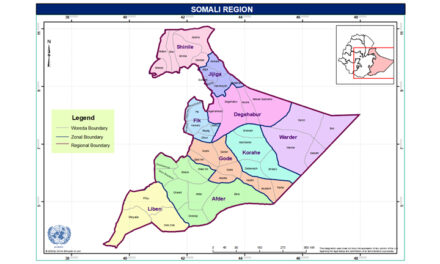
As I’m studying environmental studies at present it is really good to see positive studies/research on the effects and impacts with encouraging outcomes of this type of research.
Hi Andrew! Thanks for that feedback. We are glad that these examples are helpful and pleased to be able to share them. If you haven’t already seen it, you might be interested in the previous blog post in this series that gives some more examples of research and initiatives, here https://www.ukfiet.org/2023/education-that-listens-to-those-most-affected-by-climate-change/
Thank you for an insightful post! While it’s easy to get complacent about Climate change issues and resign to it as the ” new norm”, it’s encouraging to hold onto the fact that Climate Change Education – awareness and change ( as in your post) is ongoing , and is what makes all the difference !